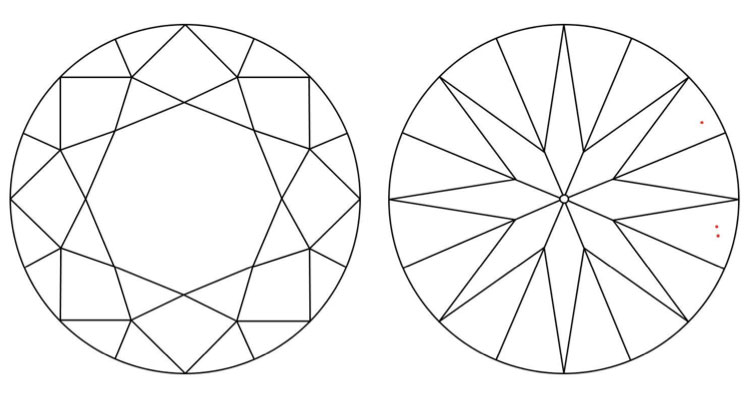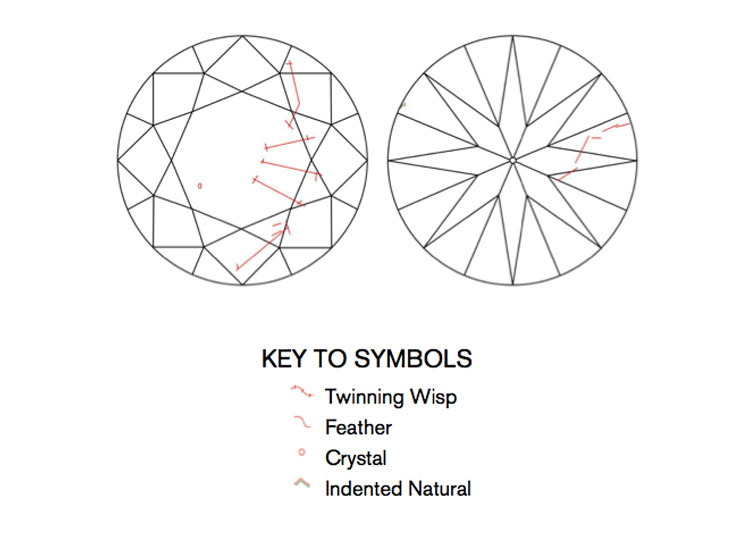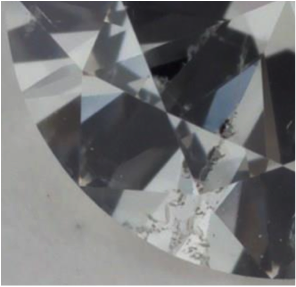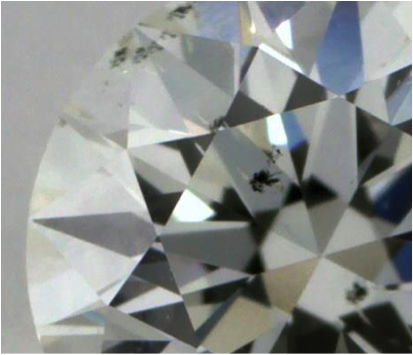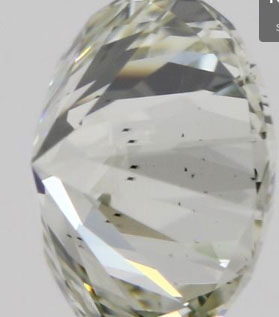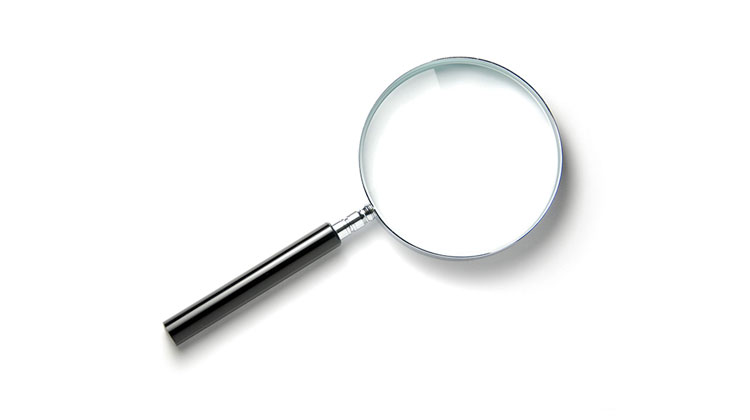
Clarity refers to the flaws in a diamond and is graded from Flawless (FL) to Included 3 (I3) by the GIA. The scale covers the following grades:
Flaws in a diamond are natural and there is no such thing as a truly flawless diamond. What you need to know is that diamond clarity is only graded under 10x magnification and this means that if you look under higher magnification, you will still see flaws in Flawless graded diamonds.
Why 10x? The truth is that there’s not a really good reason for this apart from the fact that the standard magnification for a jeweler’s loupe has always been 10x power. It is merely for convenience and is an arbitrary standard for clarity grading that doesn’t make sense to me especially for grades above VS1 where it’s difficult to spot inclusions even with a loupe.
Are you over-paying for clarity?
It all depends on your personal preferences and expectations.
Some people like high clarity diamonds even if they cannot see the inclusions with their unaided eyes (mind-clean). Certain Asian cultures have deep superstitions about diamonds and inclusions, especially dark crystal inclusions, are considered bad luck.
Others just want to get the lowest clarity diamond that they can get away with without being able to see them (eye-clean). I personally like a reasonably high clarity like a good VS1, where it is difficult to spot an inclusion even under 10x magnification (loupe-clean).
Whichever clarity you choose, the important thing is that you have your own reasons for choosing it.
- Mind Clean – FL to VVS1
- Loupe Clean – VVS2 to VS1
- Eye Clean – VS2 to SI1
Note: Not all VS2/SI1s are eye-clean but VS1s are defined to be at least eye-clean.
What is an eye-clean diamond?
Although eye-cleanliness has no gemological meaning and there are no official standards for what an eye-clean diamond is. Practically speaking eye-cleanliness is one of the most important considerations when buying a diamond. Eye-cleanliness can be highly subjective and what is eye-clean to one person may not be eye-clean to someone else so make sure you know what your seller’s definition of eye-clean is.
A complete eye-clean definition should have 4 components:
- The observer
- The viewing distance
- The viewing angle
- The lighting environment
A typical eye-clean definition goes like this:
“No visible inclusions with the diamond face up, by a person with 20/20 vision, from a distance of 8 inches, under diffuse office lighting“.
SI2 and Below
SI2 or below diamonds are too risky for me to comfortably recommend but if you can inspect the diamond in person and it is clean enough for your purposes then I think it would be a great way to save money on a diamond. If you come across the SI3 grade, please note that this is a grade used by EGL, and is not recognized by GIA or the AGS. An SI3 grade is meant to describe those diamonds that EGL felt were better than I1 but not quite SI2.
Avoid SI3 clarity diamonds as they are likely GIA I1 or I2 equivalent stones.
I1 and I2 stones are to be avoided because the inclusions in these diamonds are obvious and they are considered very low-quality diamonds.
What’s more important, color or clarity?
There are 23 color grades and only 11 clarity grades so one would expect that clarity grades aren’t as narrow as color grades. In reality, the FL to VVS1 grades are arguably narrower than the DEF color grades. On the other end of the scale, SI1 and SI2 grades are much wider than typical color grades.
The reason for this is because most diamonds are H-color and gets more rare in either direction whereas diamonds are increasingly more common with lower clarity grade. Hence what you’ll find is that the price jump from an I to an H will be less than that between an SI1 and a VS2.
Flawless and Internally Flawless
Many people think that Internally Flawless is the highest clarity grade, but Internally Flawless only means the diamond is without internal features and clarity actually covers both internal and external features. Internal features are called inclusions (or piqué) and external features are called blemishes. The difference between FL and IF is that IF diamonds may have blemishes that could not or have not been polished away. You will see on GIA reports for IF graded diamonds that there will be a comment that states “minor details of polish not shown”.
- FL – no inclusions or blemishes visible at 10x
- IF – no inclusions visible at 10x
Common inclusions you will encounter as you go down the clarity scale are (crystals, needles, feathers, clouds, pinpoints, indented natural, twining wisps, etc).
VVS1 and VVS2
A single pinpoint anywhere in the diamond will turn an IF diamond into a VVS1. Two or more pinpoints that can be seen face-up and the diamond becomes VVS2. If you want the absolute best but cannot afford a DIF then an D or E VVS1 is the next best thing. Very few diamond prosumers end up purchasing a VVS2 diamond because it is often not mind-clean yet VS1s are sufficiently loupe clean.
- VVS1 – at least one pin point
- VVS2 – at least two pin points seen face up
VS1 and VS2
Most diamond prosumers end up getting a VS1 or VS2 diamond because they are generally eye-clean. The main difference between a VS1 and a VS2 is how easy the inclusions can be seen using a 10x loupe. For diamond prosumers, I recommend VS1 if you’re going to be examining your diamond under a loupe. You can consider a VS2 if you want an eye-clean diamond but do not have the opportunity to inspect the diamond before purchase and don’t want the hassle of returning a diamond because it is not eye-clean.
- VS1 – completely eye-clean
- VS2 – eye-clean for most people from face up
Note: VS2s may not be completely eye-clean from all angles.
SI1 and SI2
If all you want is an eye-clean diamond, there are many SI1 diamonds that are eye-clean to a lot of people. There are much fewer eye-clean SI2s but they do exist, you just have to spend more time looking. Just remember what is eye-clean to you depends on a lot of things like how close you look at the diamond, your vision, lighting, and whether you know what you’re looking for and where. If you’re on a budget and need to put your dollars to work in the other Cs then SI1 is where you want to be in terms of clarity.
Now I always get asked whether a particular SI1 diamond is likely to be eye-clean based on a lab report. The truth is that it is impossible for anyone to tell just by looking at a diamond grading certificate. If you want to buy an SI1, I recommend you buy from a seller that provides 360 images of the diamond and has a written eye-clean policy.
If I were selecting a SI1 diamond for myself, I would look at the diamond from about 1 foot away under office lighting where I can have it clearly focused without straining my eyes and then tilt and turn the diamond to see if I can spot any large dark inclusions.
- SI1 – potentially eye-clean for some people
- SI2 – usually not eye-clean
I1, I2, and I3
These diamonds will typically not be eye-clean and I do not recommend buying diamonds with such low clarity grades because not only do the inclusions affect the appearance of the diamond, there will also very likely be structural issues that affect the diamond’s durability.
Clarity Plot
Many people place a lot of weight into getting a diamond with a nice clean clarity plot on the lab report like the VVS1 above. Notice there are only three pinpoint inclusions that can only be visible from the pavilion side of the diamond.
When compared to the VVS1, this SI1 diamond has a seemingly scary looking clarity plot, but I can assure you that in reality, a good looking clarity plot and a beautiful diamond has less correlation than one would imagine. The diamond above has a decent chance of being eye-clean.
There are several things you need to know briefly about the clarity plot. The first is that the clarity plot is labelled with the grade-setting inclusion first. The second is that internal features are labelled red and external features are labelled green. The plot is drawn to demonstrate the location and the rough size of the inclusion. The purpose of the clarity plot is for identification and in most cases, is not a good indicator of what the diamond actually looks like.
Common Inclusions
In general, inclusions that can only be seen from the bottom or inclusions that can be covered up with a prong are preferable to inclusions that are directly visible under the table. Transparent inclusions are preferable to white inclusions, which are preferable to dark inclusions. Try to avoid dark central inclusions in the SI1 grades.
The most common types of inclusions are crystals, feathers, pinpoints, and clouds. I’ll focus on clouds and feathers which seem to worry people the most.
Clouds are simply many pinpoints grouped together. They are called clouds because they can make the diamond look cloudy. Small clouds made up of several pinpoints generally have no effect on the appearance of the diamond. But be extremely careful when you come across a clean clarity plot for a low clarity grade accompanied with the comment “clarity grade is based on clouds not shown”. There is a chance that the diamond in question has a cloudy look to it like the diamond below. Compare the diamonds below, the diamond on the left (GIA#1126693040) is cloudy and has no fluorescence. Please bear in mind that this is an extreme example.
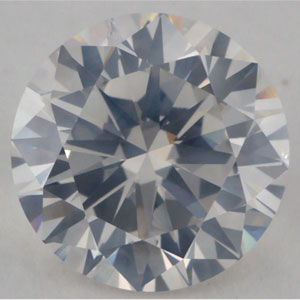
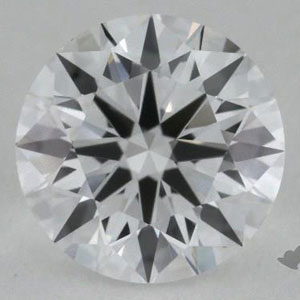
A feather is a fancy word for a crack that touches but doesn’t breach the surface of the diamond. Small feathers cannot be seen easily and can only be seen at particular angles. A VS feather is generally a non-issue.
With large feathers, there is a chance that the feather can grow over time as it gets knocked around during normal wear and tear. If the feather breaches the surface of the diamond, it would pose an even bigger durability risk.
Having said this, a diamond can have a huge feather and may never crack, but an internally flawless diamond might crack if it is struck at a precise spot where it has a cleavage plane. So please don’t worry about feathers and just treat every single diamond with care.
Less Common Inclusions
Some less common flaws but ones that seem to worry a lot of consumers are knots, naturals, twining wisps, and graining.
Knots are transparent crystals that extend to the surface of the diamond. They are more commonly found in SI clarity diamonds because there is a good chance that they are not eye-clean.
Naturals are a piece of the rough diamond that is left unpolished on the diamond. It is done to save weight. Naturals are usually external features, but an indented natural is classified as an inclusion. When naturals are near the girdle, they are fairly easy to cover using a prong when setting the diamond.
Twining wisps can be small crystals, pinpoints, or clouds. They are sometimes formed near the beginning of the diamond’s growth as a crystal itself when there is a common ‘twinning’ plane. The diamond grows out identically like ‘twins’, but in opposite directions, and that is why twining wisps often appear like a pair of inclusions as can be seen quite clearly between the arrows in the image below.
Graining can either be surface graining or internal graining, but both refer to grain boundaries that are formed as defects in the crystal structure. They can appear as a series of straight or curved white lines that may be visible under 10x magnification. Graining may appear scary to consumers because it is usually remarked as a comment “surface graining is not shown” or “internal graining is not shown”. If a diamond has heavy graining, it will look dull like it was not polished well. For more information on graining you can read my tutorial on surface vs internal graining.
Finally, a word on reflectors. A diamond’s facets are like mirrors and depending on where the inclusion is, it could be reflected once, twice, or several times. If an inclusion is reflected by a pavilion facet, even a small inclusion may appear like many inclusions and these types of inclusions are known as reflectors. Reflectors that affect the diamond face-up will be taken into account of in the grading process.
Notice how a dark inclusion inside the table can be reflected by one pavilion main onto all the other pavilion mains.
Conclusion
I am an advocate for choosing your specs wisely and unless you are a superstitiously person, I believe it would be foolish to buy a VVS1 diamond if you have to sacrifice your other preferences.
We’re done with the basics, are you ready to become a diamond prosumer? If you have questions on the basics or have something you’d like to add, please feel free to contact me.

